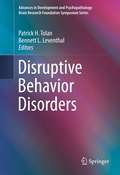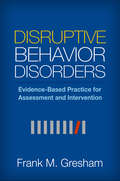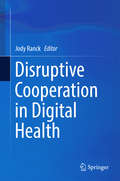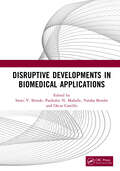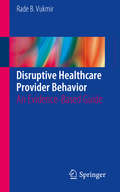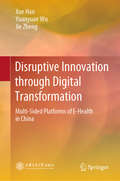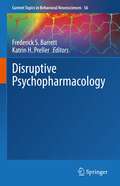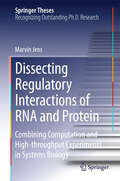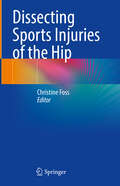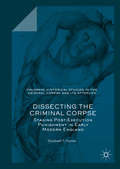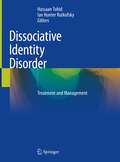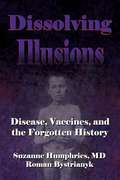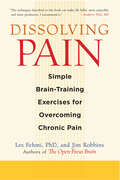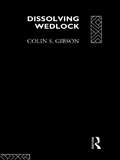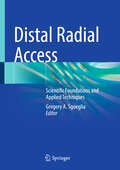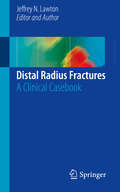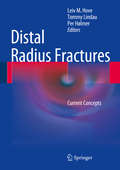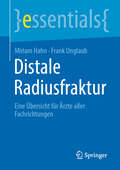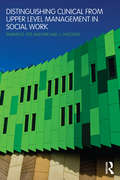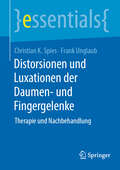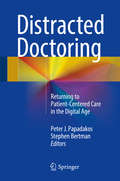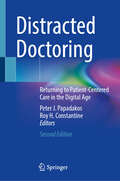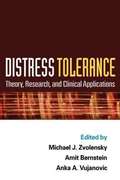- Table View
- List View
Disruptive Behavior Disorders
by Patrick H. Tolan Bennett L. LeventhalAggressive behavior among children and adolescents has confounded parents and perplexed professionals--especially those tasked with its treatment and prevention--for countless years. As baffling as these behaviors are, however, recent advances in neuroscience focusing on brain development have helped to make increasing sense of their complexity. Focusing on their most prevalent forms, Oppositional Defiant Disorder and Conduct Disorder, Disruptive Behavior Disorders advances the understanding of DBD on a number of significant fronts. Its neurodevelopmental emphasis within an ecological approach offers links between brain structure and function and critical environmental influences and the development of these specific disorders. The book's findings and theories help to differentiate DBD within the contexts of normal development, non-pathological misbehavior, and non-DBD forms of pathology. Throughout these chapters are myriad implications for accurate identification, effective intervention, and future cross-disciplinary study. Key issues covered include: Gene-environment interaction models.Neurobiological processes and brain functions.Callous-unemotional traits and developmental pathways.Relationships between gender and DBD.Multiple pathways of familial transmission. Disruptive Behavior Disorders is a groundbreaking resource for researchers, scientist-practitioners, and graduate students in clinical child and school psychology, psychiatry, educational psychology, prevention science, child mental health care, developmental psychology, and social work.
Disruptive Behavior Disorders
by Frank M. GreshamSchools often resort to ineffective, punitive interventions for the 10% of K-8 students whose challenging behavior interferes with their own and their classmates' learning. This book fills a crucial need by describing ways to provide meaningful supports to students with disruptive behavior disorders. Prominent authority Frank M. Gresham weaves together current research, assessment and intervention guidelines, and illustrative case studies. He reviews a broad range of evidence-based practices and offers recommendations for selecting, implementing, and evaluating them within a multi-tiered framework. Coverage includes school- and home-based approaches, multicomponent programs, prevention strategies, and social skills training.
Disruptive Cooperation in Digital Health
by Jody RanckThis clear-sighted volume introduces the concept of "disruptive cooperation"-- transformative partnerships between the health and technology sectors to eliminate widespread healthcare problems such as inequities, waste, and inappropriate care. Emphasizing the most pressing issues of a world growing older with long-term chronic illness, it unveils a new framework for personalized, integrative service based in mobile technologies. Coverage analyzes social aspects of illness and health, clinically robust uses of health data, and wireless and wearable applications in intervention, prevention, and health promotion. And case studies from digital health innovators illustrate opportunities for coordinating the service delivery, business, research/science, and policy sectors to promote healthier aging worldwide. Included among the topics: Cooperation in aging services technologies The quantified self, wearables, and the tracking revolution Smart healthy cities: public-private partnerships Beyond silos to data analytics for population health Cooperation for building secure standards for health data Peer-to-peer platforms for physicians in underserved areas: a human rights approach to social media in medicine Disruptive Cooperation in Digital Health will energize digital health and healthcare professionals in both non-profit and for-profit settings. Policymakers and public health professionals with an interest in innovation policy should find it an inspiring ideabook.
Disruptive Developments in Biomedical Applications
by Oscar Castillo Parikshit N. Mahalle Swati V. Shinde Varsha BendreThis book covers advancements and future challenges in biomedical application development using disruptive technologies like AI, IoT and signal processing. Book is divided into four main sections namely medical image processing using AI, IoT and biomedical devices, biomedical signal processing and electronic health records including advances in biomedical systems. It includes different case studies of biomedical applications using different AI algorithms related to diabetes, skin cancer, breast cancer, cervical cancer, osteoarthritis, and so forth. Features: Covers different technologies like AI, IOT and signal processing in the context of biomedical applications. Reviews medical image analysis, disease detection, and prediction. Comprehends the advantage of recent technologies for medical record keeping through electronics health records (EHRs). Presents state of art research in the field of biomedical engineering using various physiological signals. Explores different Bio Sensors used in Healthcare Applications using IOT. This book aims at Graduate students and researchers in artificial intelligence, medical imaging, biomedical engineering, and internet of things.
Disruptive Healthcare Provider Behavior
by Rade B. VukmirThis book explores a rapidly growing area of discussion in the health care industry, disruptive behavior in medical providers. The presence of disruptive behavior adversely impacts the providers of all disciplines: paraprofessional personnel, nurses, physicians and administrators. But more importantly, there may be a greater detrimental effect on quality and patient safety. This has led to mandated regulatory requirements that assist healthcare institutions in developing programs to address the problem. The book presents an evidence-based analysis of the disruptive provider behavior that defines the incidence, demographics, and profile of the behavior; discusses the specialties and work locations predisposed, as well as the interface with residents and nurses. The importance of patient safety, economic, and legal issues are addressed by a comprehensive, management strategy to effect positive, sustainable culture change in healthcare.
Disruptive Innovation through Digital Transformation: Multi-Sided Platforms of E-Health in China
by Jie Zheng Xue Han Yuanyuan WuThe book addresses the prevalent digital transformation and focuses on its significant disruption in healthcare. In light of the distinctive characteristics and evolution of the Chinese healthcare industry, private multi-sided platform (MSP) companies emerge to offer novel values and explore the industry value chain. Drawing on the management and economics literature of MSPs, this book examines the selected Chinese MSPs and compares them with the counterpart MSPs in the U.S. This analysis highlights how the unfolding healthcare disruption is valuable for both scholars and practitioners to understand the trends and to take effective actions. “Disruptive Innovation through Digital Transformation: Multi-Sided Platforms of E-Health in China” provides readers in the developing and developed countries with insights on how to approach the current multi-sided platform and to resolve the current problems to better serve customers and patients in the healthcare market.
Disruptive Psychopharmacology (Current Topics in Behavioral Neurosciences #56)
by Frederick S. Barrett Katrin H. PrellerPsychedelic therapies are gaining traction as potential treatments for a wide range of indications, but the structure and delivery of psychedelic therapies are a sharp departure from more traditional models of psychotherapy and pharmacotherapy for psychiatric and other medical disorders. This may be critical to their success. The current volume provides a comprehensive review of the state of the science of psychedelic therapies, including discussion of models and approaches to psychedelic therapies as well as the current status of safety and efficacy data for mood, substance use, trauma, obsessive-compulsive, neurodevelopmental, neurodegenerative disorders, neurological, and inflammatory disorders.
Dissecting Regulatory Interactions of RNA and Protein
by Marvin JensThe work described in this book is an excellent example of interdisciplinary research in systems biology. It shows how concepts and approaches from the field of physics can be efficiently used to answer biological questions and reports on a novel methodology involving creative computer-based analyses of high-throughput biological data. Many of the findings described in the book, which are the result of collaborations between the author (a theoretical scientist) and experimental biologists and between different laboratories, have been published in high-quality peer-reviewed journals such as Molecular Cell and Nature. However, while those publications address different aspects of post-transcriptional gene regulation, this book provides readers with a complete, coherent and logical view of the research project as a whole. The introduction presents post-transcriptional gene regulation from a distinct angle, highlighting aspects of information theory and evolution and laying the groundwork for the questions addressed in the subsequent chapters, which concern the regulation of the transcriptome as the primary functional carrier of active genetic information.
Dissecting Sports Injuries of the Hip
by Christine FossThe book is intended to enable the healthcare professional to have a broader scope of clinical practice in treating sports injuries of the hip. The text serves as an in-depth dive into the assessment, gross survey, diagnostic imaging, and recovery of sports injuries of the hip region. Taking the theme of gross dissection lab and making it applicable to clinical practice, this text essentially dissects each of the injuries in layers, from the deepest intra-articular pathologies to the most superficial fascial trends. Additionally, the book details assessment skills, diagnostic imaging, and a recovery plan that will facilitate proper treatment strategies. Chapters provide an in-depth look at each sports injury in a format that is comprehensible and clinically relevant to healthcare professionals, such as physical therapists, chiropractors, athletic trainers, and primary care physicians. Using assessment skills, gross-dissection survey, diagnostic-imaging techniques, and recovery tools, the book pulls together the full perspective of injury care and recovery strategies for the healthcare professional catering to the athletic population. Dissecting Sports Injuries of the Hip enables sports practitioners to have a broader scope of clinical practice, more accurate diagnostic skills, and essential tools on the care path to returning the athlete to sport safely, post-injury to the hip.
Dissecting the Criminal Corpse
by Elizabeth T. HurrenThose convicted of homicide were hanged on the public gallows before being dissected under the Murder Act in Georgian England. Yet, from 1752, whether criminals actually died on the hanging tree or in the dissection room remained a medical mystery in early modern society. Dissecting the Criminal Corpse takes issue with the historical cliché of corpses dangling from the hangman's rope in crime studies. Some convicted murderers did survive execution in early modern England. Establishing medical death in the heart-lungs-brain was a physical enigma. Criminals had large bull-necks, strong willpowers, and hearty survival instincts. Extreme hypothermia often disguised coma in a prisoner hanged in the winter cold. The youngest and fittest were capable of reviving on the dissection table. Many died under the lancet. Capital legislation disguised a complex medical choreography that surgeons staged. They broke the Hippocratic Oath by executing the Dangerous Dead across England from 1752 until 1832. This book is open access under a CC-BY license.
Dissent in Medicine: Nine Doctors Speak Out
by The New Medical FoundationThese essays are about different dimensions of modern medicine such as how much science is there in modern medicine, treatment for some cancers, environmental issues in medicine, choking, drowning and resuscitation, corruption in American medicine, the accuracy of medical testing, effectiveness of treatment, immunizations and hospital births.
Dissociative Identity Disorder: Treatment and Management
by Hassaan Tohid Ian Hunter RutkofskyThis book contains new evidence and more ideas for treatment and management of dissociative identity disorder (DID). It is written from the standpoint of an expert in the field for other professionals that deal with or are interested in DID. Chapters are divided into 4 parts. Part 1 acts as an introduction to understanding dissociative identity disorder, such its history, the different types of the disorder, and its portrayal in popular culture. The chapters in this part cover multiple personality disorder, theories, and epidemiology of the disease. Part 2 discusses the pathology and neuroscience of the disease. The comorbidities related to the disorder will be explained, such as PTSD, depression, anxiety, schizophrenia, and more. This part concludes with the potential causes of dissociative identity disorder, which ties into the previously mentioned comorbidities throughout this part. Supplementing the aforementioned topics, Part 3 discusses management of the disease. The chapters will cover modern psychiatry, diagnosis, and treatment options. Drug treatment and psychotherapy are some examples of the treatment options available. The authors share their experiences and perspectives of managing DID, including clinical trials and recovery. Finally, Part 4 discusses the sociology of DID, such as potential drug abuse, social media presence, and the difficulties that psychiatrists face in diagnosing the disease. This part provides advice for clinicians and healthcare providers by sharing different perspectives from psychiatrists that encounter the disease. Written by experts in the field, Dissociative Identity Disorder serves as a valuable resource for psychiatrists and clinicians seeking to understand, treat, and manage the disease.
Dissolving Illusions: Disease, Vaccines, and the Forgotten History
by Suzanne Humphries Roman BystrianykNot too long ago, lethal infections were feared in the Western world. Since that time, many countries have undergone a transformation from disease cesspools to much safer, healthier habitats. Starting in the mid-1800s, there was a steady drop in deaths from all infectious diseases, decreasing to relatively minor levels by the early 1900s. The history of that transformation involves famine, poverty, filth, lost cures, eugenicist doctrine, individual freedoms versus state might, protests and arrests over vaccine refusal, and much more. Today, we are told that medical interventions increased our lifespan and single-handedly prevented masses of deaths. But is this really true?Dissolving Illusions details facts and figures from long-overlooked medical journals, books, newspapers, and other sources. Using myth-shattering graphs, this book shows that vaccines, antibiotics, and other medical interventions are not responsible for the increase in lifespan and the decline in mortality from infectious diseases. If the medical profession could systematically misinterpret and ignore key historical information, the question must be asked, "What else is ignored and misinterpreted today?"Perhaps the best reason to know our history is so that the worst parts are never repeated.
Dissolving Pain: Simple Brain-Training Exercises for Overcoming Chronic Pain
by Jim Robbins Les FehmiFor four decades, Dr. Les Fehmi has been training people to regulate their own brainwave patterns to improve their mental, emotional, and physical health. His new book focuses on the treatment of pain, and it is based on the premise that although pain is perceived to exist in a particular part of the body, pain actually arises in the brain.Drawing on existing scientific research and on decades of clinical experience, he offers brain-training exercises that quiet the pain signal in the brain. The exercises involve altering the way we pay attention to pain, cultivating what Fehmi calls Open-Focus Attention: a relaxed form of awareness that changes the neural blood flow and increases alpha brainwave activity (associated with reduced stress and beneficial hormonal changes). These exercises are effective in the treatment of many forms of pain including back, shoulder, neck, and joint pain; headaches; muscle pain and tension; and pain from traumatic injury.Included with the book is a 60-minute program that guides listeners through the Open-Focus exercises to help them to become pain free.
Dissolving Wedlock
by Dr Colin Gibson Colin GibsonThe divorce rate has been rising significantly throughout the twentieth century. By interweaving the historical, demographic, sociological, legal, political and policy aspects of this increase, Colin Gibson explores the effects it has had on family patterns and habits. Dissolving Wedlock presents a multi-disciplinary examination of all the socio-legal consequences of family breakdown. Dissolving Wedlock will be invaluable reading to all lecturers and students of social policy, sociology and social work as well as to professionals and lawyers working in the field of divorce.
Distal Radial Access: Scientific Foundations and Applied Techniques
by Gregory A. SguegliaThis is the first book devoted entirely to distal radial access, a novel vascular access technique that has become a major topic of interest in interventional cardiology, interventional radiology and neurointervention. The rapid spread of distal radial access through social media has been remarkable, reflecting the wide curiosity surrounding this approach. While almost every interventionalist is aware of it, many have yet to fully grasp its clinical significance and the nuances of its proper implementation. Given its growing importance, this topic warrants a more structured, rigorous and comprehensive discussion. This volume aims to elucidate the scientific basis of distal radial access and provide a thorough critical review of the existing literature. Each chapter focuses on a different aspect of the technique and is written by leading experts from different institutions, ensuring a diverse perspective that enriches the content. With its commitment to scientific excellence, this book serves as the most comprehensive and up-to-date reference on distal radial access, written by the very pioneers who have contributed to its development and evaluation. It is intended primarily for interventional cardiologists, interventional radiologists, and neurointerventionalists who wish to improve their understanding and clinical practice in this evolving field.
Distal Radius Fractures
by Jeffrey N. LawtonBased exclusively upon clinical cases covering fractures of the distal radius, this concise, practical casebook will provide orthopedic surgeons and sports medicine specialists with the best real-world strategies to properly manage the multifaceted surgical techniques for management of the distal radius and distal radial ulnar joint (DRUJ). Each chapter begins with a case that opens with a unique clinical presentation, followed by a description of the diagnosis, assessment and management techniques used to treat it, as well as the case outcome and clinical pearls and pitfalls. Cases included illustrate the various uses of the volar locking plate for metaphyseal and periarticular fractures, among others, as well as management strategies for open reduction internal fixation (ORIF) for the radial styloid. Ulnar styloid and ulnar head/neck fractures are likewise described. Pediatric distal radius fractures and complications round out the presentation. Pragmatic and reader friendly, Distal Radius Fractures: A Clinical Casebook will be an excellent resource for orthopedic surgeons, hand and upper extremity surgeons and sports medicine specialists confronted with both common and complex fractures to the distal radius and DRUJ.
Distal Radius Fractures
by Leiv M. Hove Tommy Lindau Per HølmerThis textbook aims to provide the reader with a complete understanding of distal radius fractures, their inherent problems, and how to manage them successfully. It is written by widely published experts from a part of the globe where distal radius fractures are very common, especially during the winter months. Clear guidance is provided on diagnostic imaging, classification, and assessment of fracture instability. The complete spectrum of operative and nonoperative treatment options are then clearly explained with the aid of step-by-step illustrations. Extensive information is also provided on complications and their treatment. Both students and experienced practitioners will find this book to be an enlightening, practice-oriented reference on the management of these challenging fractures.
Distale Radiusfraktur: Eine Übersicht für Ärzte aller Fachrichtungen (essentials)
by Frank Unglaub Miriam HahnDiese Broschüre thematisiert die diagnostischen und therapeutischen Möglichkeiten bei der distalen Radiusfraktur. Es handelt sich um eine häufige Fraktur, von der sowohl junge als auch ältere Menschen betroffen sind. Auch wenn sich in den letzten Jahren eine Tendenz zur operatven Versorgung der Fraktur beobachten lässt, muss in jedem Fall individuell entschieden werden, ob das Therapieziel der anatomischen Rekonstruktion besser über eine operative oder eine konservative Behandlung erreicht werden kann. Um das funktionelle Ergebnis zu optimieren, ist es darüber hinaus wichtig, Begleitverletzungen und Komplikationen zu erkennen.
Distinguishing Clinical from Upper Level Management in Social Work
by Michael J. Holosko Marvin D. FeitOver the past few decades, as administrative and technological complexity has increased, so has the role and importance of administrative practice in social work. For those making the switch from front-line practice to administration and management there is, therefore, a real need to prepare and enhance the knowledge base and skill set necessary at the executive level. In particular, the importance of budgeting and fiscal management, the need for accountability, negotiation between different and competing organizations, along with an understanding of decision-making, planning, and understanding levels of risk. Written by two experienced authors within social work education, this practical workbook presents the interrelated nature of decision-making, and provides a model for understanding what is required in the transition from clinician, to clinical and upper level management. The text covers: The difference between clinical and upper level management skills The major trends that influence health and human service organizations An analysis of the concept of leadership The skills needed by Clinical Managers and Upper Level Managers to administer effectively. Distinguishing Clinical and Upper Level Management is a much needed update to the field of management and administration within human service organizations, and will be important reading for social work students, social service professionals, and other human service providers.
Distorsionen und Luxationen der kleinen Gelenke an Finger und Daumen (essentials)
by Frank Unglaub Christian K. SpiesDiese Brochüre thematisiert die diagnostischen und therapeutischen Möglichkeiten der Distorsions- und Luxationsverletzungen an Finger- und Daumengelenken. Es sind häufige Verletzungen, die vor allem während sportlicher Aktivitäten, wie Kontakt-, Ball- oder Risikosportarten, erlitten werden. Aber auch handwerkliche Berufe sind in diesem Zusammenhang mit einem erhöhten Risiko für Verletzungen assoziiert. Diese Faktoren in Verbindung mit einer zunehmend älteren und aktiven Gesellschaft untermauern die steigende Bedeutung dieser Verletzungen im medizinischen Alltag mit nicht unerheblichen sozio-ökonomischen Konsequenzen.
Distracted Doctoring
by Peter J. Papadakos Stephen BertmanExamining-room computers require doctors to record detailed data about their patients, yet reduce the time clinicians can spend listening attentively to the very people they are trying to help. This book presents original essays by distinguished experts in their fields, addressing this critical problem and making an urgent case for reform, because while electronic technology has revolutionized the practice of medicine, it also poses a unique challenge to health care. Smartphones in the hands of doctors and nurses have become dangerously seductive devices that can endanger their patients. Distracted Doctoring is written for anesthesiologists and surgeons, as well as general practitioners, nurses, and healthcare administrators, chapters include Medicine Enters the Computer Age, Electronic Addiction, Electronic Distraction and Physician Empathy, and the Impact of Computer Use on Physician-patient Communication.
Distracted Doctoring: Returning to Patient-Centered Care in the Digital Age
by Peter J. Papadakos Roy H. ConstantineThe problems related to clinical distractions have grown in a brief amount of time. In addition to the expended use of electronic medical records, handheld technologies, and AI, staffing issues are reaching crisis levels. There is a considerable threat to patient safety, professional performance, and wellness. This book exposes the breadth or risks covered in the previous edition while expanding into new topics. The team of authors represents a diverse group of experts that offer different perspectives. Distracted Doctoring is written for physicians, including anesthesiologists, surgeons and general practitioners, PAs, NPs, nurses, pharmacists, technologists, other members of the health care team (clinical and non-clinical), researchers, health care administrators and students.
Distracted: How Regulations Are Destroying the Practice of Medicine and Preventing True Health-Care Reform
by Matthew HahnAfter the many bureaucratic changes that followed the passing of the Affordable Care Act (Obamacare) and other legislation, patient care has become secondary to satisfying the whims of government and giant insurance company administrators, who are in total control. The result is a web of complicated rules and misguided programs whose chief effect has been to distract doctors and nurses from their proper focus on patient care. Access to health care now depends on the ability of patients, doctors, and nurses to navigate in and around this cumbersome and ever-changing system.Written by a practicing doctor and based on years of real-life experience, Distracted takes the unique view that it is not the American health care system that is broken—the problem lies in the administration of health care. The solution is simplicity where there is complexity. The solution is an elegant use of health information technology to foster improved care. It is putting control of health care decisions back with those who know best, patients and their health care teams.The solution is caring for patients with fewer distractions.
Distress Tolerance
by Michael Zvolensky Amit BernsteinThis state-of-the-art volume synthesizes the growing body of knowledge on the role of distress tolerance the ability to withstand aversive internal states such as negative emotions and uncomfortable bodily sensations in psychopathology. Prominent contributors describe how the construct has been conceptualized and measured and examine its links to a range of specific psychological disorders. Exemplary treatment approaches that target distress tolerance are reviewed. Featuring compelling clinical illustrations, the book highlights implications of the research for better understanding how psychological problems develop and how to assess and treat them effectively.
